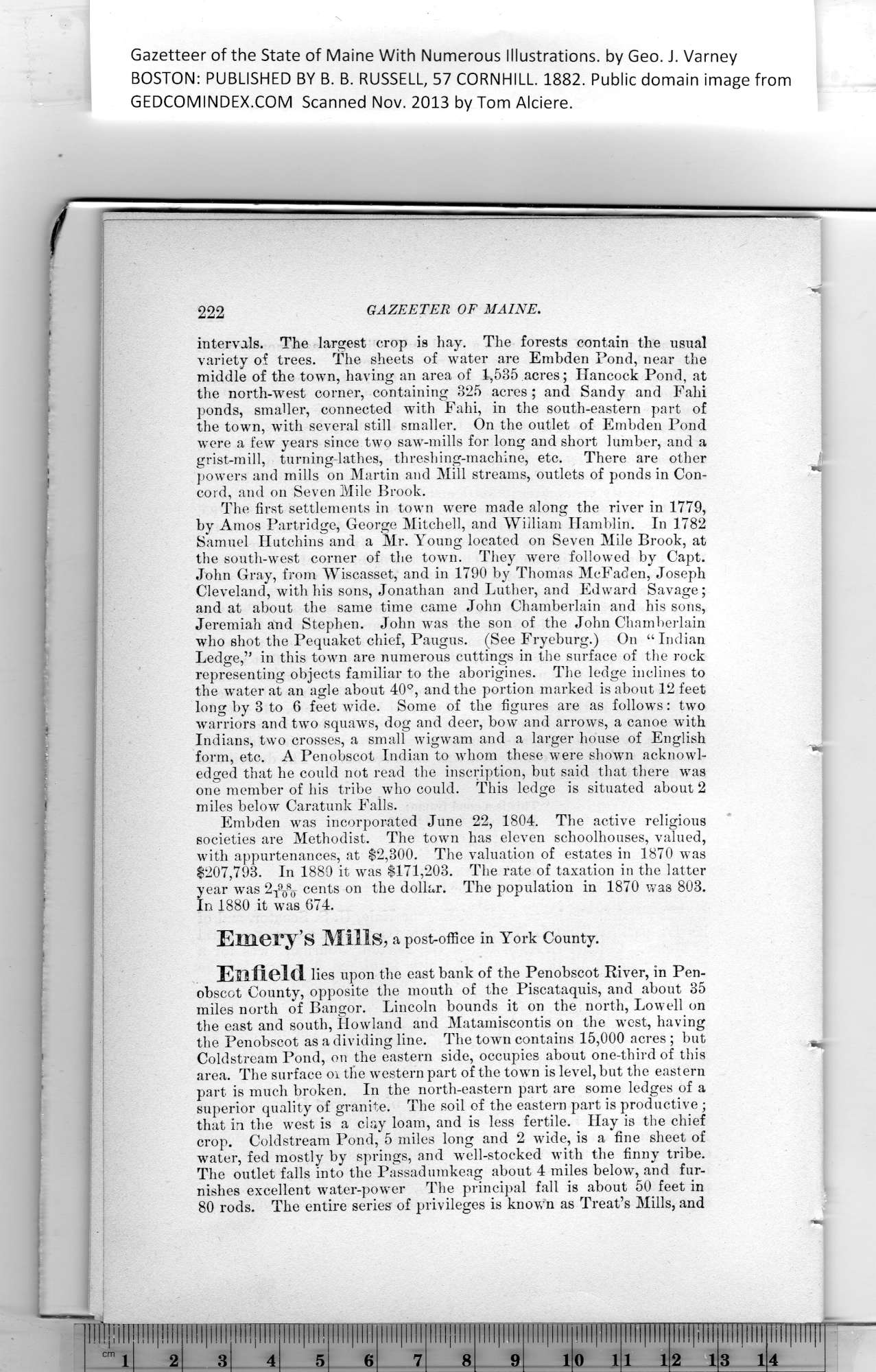|
Gazetteer of the State of Maine With Numerous Illustrations, by Geo. J. Varney
BOSTON: PUBLISHED BY B. B. RUSSELL, 57 CORNHILL. 1882. Public domain image from
222 GAZEETER OF MAINE.
intervals. The largest crop is hay. The forests contain the usual
variety of trees. The sheets of water are Embden Pond, near the
middle of the town, having an area of 1,535 acres; Hancock Pond, at
the north-west corner, containing 325 acres ; and Sandy and Fahi
ponds, smaller, connected with Fahi, in the south-eastern part of
the town, with several still smaller. On the outlet of Embden Pond
were a few years since two saw'-mills for long and short lumber, and a
grist-mill, turning-lathes, threshing-machine, etc. There are other
powers and mills on Martin and Mill streams, outlets of ponds in Con-
cord, and on Seven Mile Brook.
The first settlements in town were made along the river in 1779,
by Amos Partridge, George Mitchell, and William Hamblin. In 1782
Samuel Hutchins and a Mr. Young located on Seven Mile Brook, at
the south-west corner of the town. They were followed by Capt.
John Gray, from Wiscasset, and in 1790 by Thomas McFaden, Joseph
Cleveland, with his sons, Jonathan and Luther, and Edward Savage;
and at about the same time came John Chamberlain and his sons,
Jeremiah and Stephen. John was the son of the John Chamberlain
who shot the Pequaket chief, Paugus. (See Fryeburg.) On “Indian
Ledge,” in this town are numerous cuttings in the surface of the rock
representing objects familiar to the aborigines. The ledge inclines to
the wrater at an agle about 40°, and the portion marked is about 12 feet
long by 3 to 6 feet wide. Some of the figures are as follows: two
warriors and two squaws, dog and deer, bow and arrows, a canoe with
Indians, two crosses, a small wigwam and a larger house of English
form, etc. A Penobscot Indian to whom these were shown acknowl-
edged that he could not read the inscription, but said that there was
one member of his tribe who could. This ledge is situated about 2
miles below Caratunk Falls.
Embden was incorporated June 22, 1804. The active religious
societies are Methodist. The town has eleven schoolhouses, valued,
with appurtenances, at $2,300. The valuation of estates in 1870 was
$207,793. In 1880 it was $171,203. The rate of taxation in the latter
year was 2^8o cents on the dollar. The population in 1870 was 803.
In 1880 it was 674.
Emery’s Mills, a post-office in York County.
Enfield lies upon the east bank of the Penobscot River, in Pen-
obscot County, opposite the mouth of the Piscataquis, and about 35
miles north of Bangor. Lincoln bounds it on the north, Lowell on
the east and south, Howland and Matamiscontis on the west, having
the Penobscot as a dividing line. The town contains 15,000 acres ; but
Coldstream Pond, on the eastern side, occupies about one-third of this
area. The surface oi the western part of the town is level, but the eastern
part is much broken. In the north-eastern part are some ledges of a
superior quality of granite. The soil of the eastern part is productive ;
that in the west is a clay loam, and is less fertile. Hay is the chief
crop. Coldstream Pond, 5 miles long and 2 wide, is a fine sheet of
water, fed mostly by springs, and well-stocked with the finny tribe.
The outlet falls into the Passadumkeag about 4 miles below, and fur-
nishes excellent water-power The principal fall is about 50_ feet in
80 rods. The entire series of privileges is known as Treat’s Mills, and
PREVIOUS PAGE ... NEXT PAGE
This page was written in HTML using a program written in Python 3.2
|
